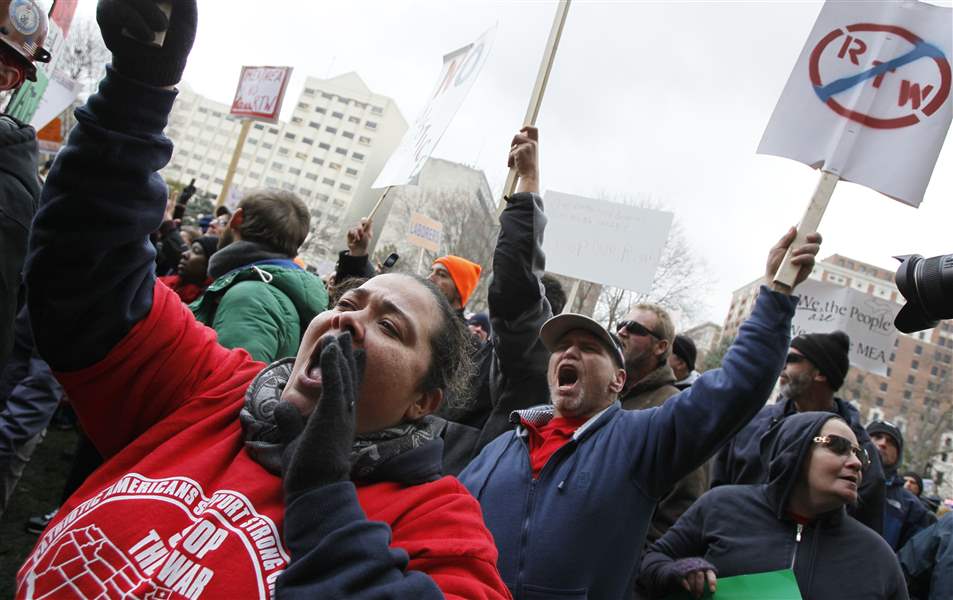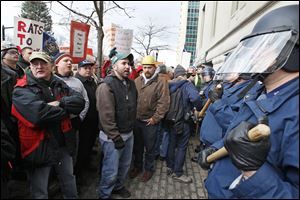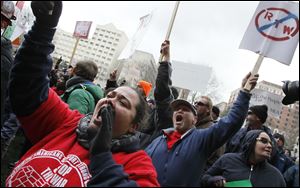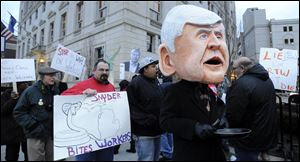
Ohio an island among right-to-work states
8/26/2018
Demonstrators protest against right-to-work legislation at the Michigan State Capitol in Lansing, Michigan, Tuesday, December 11, 2012. THE BLADE/DAVE ZAPOTOSKY
The Blade/Dave Zapotosky
Buy This Image
COLUMBUS — Ohio is surrounded by right-to-work states on every border save one.
Among the Buckeye State’s neighbors, only Pennsylvania is outside the 28 states that count themselves as right to work by declaring that workers cannot be forced, either by an employer or by the terms of a union contract, to join a workplace bargaining unit. They also cannot be forced to pay so-called “fair-share fees” in lieu of dues in order to benefit from the contract the union negotiates.
Supporters of right-to-work say the principle promotes business growth and helps attract good jobs away from states with forced union membership.

Demonstrators protest against right-to-work legislation in Michigan in 2012, before Gov. Rick Snyder signed right-to-work into law. Many of Ohio's neighboring states have adopted right-to-work, which supporters claim can help lure jobs from states with forced union membership.
But Ohio’s ranking in at least one national survey suggests things aren’t that simple. Despite being an island in a sea of right-to-work, Ohio ranks among Site Selection magazine’s top 10 state business climates. And the state routinely ranks high on the magazine’s list of favorite places for the siting of big-ticket corporate projects.
Mark Arends, the magazine’s editor-in-chief, noted that being a right-to-work state is not among the top reasons cited by companies for why they choose to locate in a state.
“But if a company had some labor issues in the past or is looking for an environment where that wouldn’t be an issue, it might be an issue for them,” he said. “Not every company is running that filter.”
On Site Selection’s list of best business climates in 2017, Ohio ranked fourth — behind Georgia, North Carolina, and Texas, in that order. Half of a state’s performance is based on surveys of corporate site selectors and the other half on the raw number of new projects year to year, the number of new projects per capita, taxes, and other data.
Every other state in the top 10 is right to work, including two of Ohio’s neighbors — Kentucky at eighth, and Indiana, tied for 10th. Michigan came in 14th.
“Several years ago when Indiana was made right-to-work, site consultants said they would put Indiana back on the list for companies looking at the Midwest,” Mr. Arends said. “Anecdotally, several consultants were telling me that.”

Demonstrators protest against right-to-work legislation at the Michigan State Capitol in Lansing, Michigan, Tuesday, December 11, 2012. THE BLADE/DAVE ZAPOTOSKY
Ohio’s other two neighbors, Pennsylvania and West Virginia, did not make the top 25.
Matt Englehart — spokesman for JobsOhio, the state’s non-profit corporation tasked with negotiating economic development deals — agreed that right-to-work is among issues some site selectors consider. But he and other experts said other factors play a bigger role.
“In my experience, investors looking at the state of Ohio put numerous conditions ahead of right to work, including the availability of a qualified skilled workforce, tax structure, incentives, access to water, access to natural gas, infrastructure, access to population, and other logistical considerations,” said Matt Szollozi, former Toledo-area state representative and current executive director of the Affiliated Construction Trades of Ohio.
Most experts agree that higher unionization leads to higher wages and better benefits and that right-to-work laws lead to lower union participation.
“With the trade union movement in America and Ohio in particular, it was unions that set the bar for wages, whether you were a union worker or not,” said Tim Burga, president of the Ohio AFL-CIO. “It’s pretty clear when you look at the states that have gone right-to-work what it has done for wages and accidents in the workplace.”
While the experience in right-to-work states has been lower union participation as a whole, Mr. Burga pointed to teacher unions in states like West Virginia, Kentucky, and Oklahoma where strikes have re-emerged as a means to hike salaries and push back against a decade of state budget cuts to schools.
Studies into whether right-to-work is a factor in a state’s overall economic performance — including job creation — have been all over the map.
On March 28, 2013, Michigan’s “Freedom to Work” laws took effect. Impacts have been felt gradually as contracts already in place at the time of the laws’ effective date took time to expire.
According to the U.S. Department of Labor, the percentage of workers in Michigan who were members of unions has declined from 16.6 percent in 2012 — the last year before the new laws took effect — to 15.6 percent in 2017.
During the same period, Indiana declined from 9.1 percent to 8.9 percent. Ohio remained largely stable, dropping just a tenth of a point to 12.5 percent during this time.
As of June, both Ohio and Michigan had an unemployment rate of 4.5 percent, above the national rate of 4.2 percent.
“If you looked at 2011-2012, Michigan has had a better recovery, a bigger fall in the unemployment rate, than Ohio has had,” said Richard Vedder, distinguished professor of economics emeritus at Ohio University in Athens who has closely studied right-to-work.
In March 2013, as Michigan’s right-to-work law took effect, Ohio’s jobless rate stood at 7.6 percent while Michigan’s stood at 9.0 percent. The Wolverine State’s recovery may have been helped to a greater degree by the rebound in the heavily unionized auto industry.
“The hot state is Indiana where the rate is 3.3 percent, way below Ohio and Michigan,” Mr. Vedder said. “Indiana has had right-to-work the longest, so it may take more time to gel and get the word out on it so that people realize it’s a permanent thing.”
A 2017 study conducted by the Illinois Economic Policy Institute and the University of Illinois at Urbana-Champaign compared three Midwest right-to-work states — Michigan, Indiana, and Wisconsin — with three Midwest non-right-to-work states — Ohio, Illinois, and Minnesota.
Looking at numbers through 2016, it found that workers on average in the right-to-work states earned 8 percent less per hour than their counterparts in the non-right-to-work states. Union membership was on average 11.5 percent in the right-to-work states compared to 13.7 percent in the non-right-to-work states.
Unemployment rates were also lower in right-to-work states.
“I wouldn’t expect the trajectory to have changed,” said the study’s co-author, Bob Bruno, professor and director at the school’s Labor Education Program. “The comparison would still hold.”
The gap between right-to-work and non-right-to-work states just became narrower with the U.S. Supreme Court ruling that struck down mandatory fair-share fees by public employees who refuse to join workplace unions.

Protesters stand outside the Detroit Athletic Club in Detroit on Thursday, March 28, 2013. Unionized workers and others plan to protest outside the Detroit Athletic Club as Gov. Rick Snyder will address a 'Pancakes & Politics' breakfast. The protesters are demonstrating against the right-to-work law that takes effect Thursday that allows workers to decide not to pay dues to a union as a condition of employment. (AP Photo/Detroit News, David Coates) DETROIT FREE PRESS OUT; HUFFINGTON POST OUT
With the drop in union membership, coupled with the end of fair-share fees from the recent Supreme Court ruling, Ohio University’s Mr. Vedder said right-to-work may become less a factor in economic decisions over time.
“We’re referring to a smaller part of the workforce than before, so that’s possible,” he said. “We’ll have to see.”
But it is a factor now, he said.
Andy Doehrel, president of the Ohio Chamber of Commerce, said the chamber has supported the concept going back to 1958 when a nasty fight over a right-to-work ballot issue cost Republicans the governor’s mansion and other state offices.
“[Gov. John] Kasich has said he doesn’t believe there’s a need for right-to-work in Ohio,” he said. “How do you run a successful ballot issue if the head of Ohio and public policy says it is not a good thing to do?”
He said Attorney General Mike DeWine, the Republican candidate this year to succeed Mr. Kasich, recently told the chamber it’s not a high priority for him, either. Mr. DeWine has also won the backing of some construction trades, something unlikely to happen if they believed he’d pursue right-to-work.
Richard Cordray, the Democratic former federal consumer watchdog and state attorney general, has the backing of big labor in his run for governor and opposes right-to-work.
Jeffrey Haymond, dean of Cedarville University’s School of Business Administration, agrees that studies have shown a downward effect on union membership and, in turn, wages, in the short term. But he questioned what the long-term broader effect would be on a state’s economy.
He said it’s premature to say what would happen in Ohio if it followed the lead of all but one of the states around it.
“Right now we’re having a boom in our economy, so we could say Ohio doesn’t need right-to-work,” Mr. Haymond said. “But would we have boomed even more if we had right-to-work in manufacturing?”
Contact Jim Provance at jprovance@theblade.com or 614-221-0496.